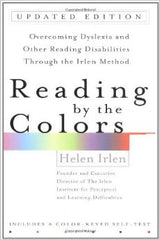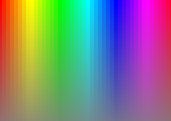What is Irlen Syndrome?
 Imagine looking at a page of a typical book - black letters on a crisp white background. Now imagine seeing the words move in star patterns or shift back and forth, creating an interference across the page. Do you think that might impact your ability to decode and read the text? A recent visitor to our convention booth described only being able to see the word she was reading; everything else was gone, lost in a moving star pattern. These are just some of the many symptoms experienced by those with Irlen Syndrome, also known as Scotopic Sensitivity Syndrome.
Imagine looking at a page of a typical book - black letters on a crisp white background. Now imagine seeing the words move in star patterns or shift back and forth, creating an interference across the page. Do you think that might impact your ability to decode and read the text? A recent visitor to our convention booth described only being able to see the word she was reading; everything else was gone, lost in a moving star pattern. These are just some of the many symptoms experienced by those with Irlen Syndrome, also known as Scotopic Sensitivity Syndrome.
This week is Irlen Syndrome Awareness Week, and we will be posting a series of articles that provide background, insights, and resources for those with this unique and somewhat controversial condition affecting a significant percentage of people across the globe.
History
Irlen Syndrome was first described by school psychologist Helen Irlen in the early 1980s as part of a federally funded California State University-Long Beach study of adult learning disabilities (1). Prior to this study, Irlen made many observations while testing and tracking students who had been identified with potential learning disabilities. She noticed a sizable portion of children who tested negative for learning disabilities on standa rdized tests yet persisted in experiencing learning-related problems in the classroom. In addition, those who tested positively for learning disabilities did not always benefit from the proscribed interventions (2). The landmark CSU-Long Beach study of over 1,500 adults began to show that not all people see the same thing when looking at a page of text. Some of the descriptions made it clear that certain distortions people experienced were primary inhibitors to their ability to read successfully.
rdized tests yet persisted in experiencing learning-related problems in the classroom. In addition, those who tested positively for learning disabilities did not always benefit from the proscribed interventions (2). The landmark CSU-Long Beach study of over 1,500 adults began to show that not all people see the same thing when looking at a page of text. Some of the descriptions made it clear that certain distortions people experienced were primary inhibitors to their ability to read successfully.
It is one thing to describe a problem, but an entirely different matter to address it. Many experiments failed until one day a student placed a colored overlay (borrowed from another student who used it for vision exercises) over the text and exclaimed she could read it. Unfortunately, the other students did not have a similar experience. But Irlen eventually discovered that the right overlay color varied significantly, appearing unique to each individual. She also discovered that other factors, such as background lighting (particularly florescent), had negative effects.
In time, more formal evaluation and intervention techniques were developed including varieties of color overlays and glasses with colored lenses. But while some technological interventions are available, we have found them to be surprisingly new and under-developed.
Controversy
At Open LORE, we believe Irlen Syndrome is a condition that deserves attention, based on the regular number of people we interact with who describe their experience in vivid detail - even those unaware that such a condition has been studied. There is also extensive ongoing research on the condition. And yet, there is much skepticism in the formal learning disability world. Why is that? A quick search for Scotopic Sensitivity or Irlen elicits articles with a wide range of perspectives.

While the research clearly distinguishes Irlen Syndrome as a condition different than classic dyslexia, the unfortunate situation is that the term "dyslexia" itself is often used to describe a great variety of brain make-ups across society. This may be contributing to the general disagreements we find as individuals describe different parts of the "proverbial elephant." The truth is that reading problems can be manifested by many different cognitive processes with underlying causes from injury to brain type diversity. For a comprehensive overview we recommend reading Proust and the Squid by Maryanne Wolf.
In the end, it is hard to argue with a real person who sees interference patterns on a page, then can read easily with a color overlay. Interventions are straightforward to implement and relatively inexpensive. Our next blog article will detail what these interventions are and how to access them, including through Open LORE reading software.
(1) Reading by the Colors, Helen Irlen, pg. 16
(2) Reading by the Colors, Helen Irlen, pg. 13-16
